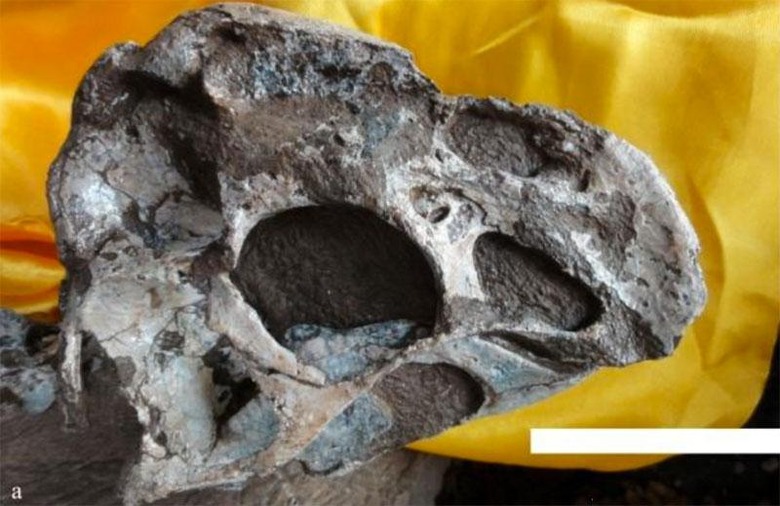Dinosaur Games: Mud Dragon Strikes Out In Ancient Pit
Tongtianlong limosus, the Mud Dragon, was caught in sticky mud in China over 66 million years ago – and died there. Of course it wasn't called China back then, and this was when our planet looked a lot different from what it looks like today. But back between 66 and 72 million years ago, the Mud Dragon gasped its last. Not long after the death of the Mud Dragon, our Earth changed drastically.
This beast was found in the Ganzhou area of southern China. There it was named Tongtianlong limosus, or "muddy dragon on the road to heaven." The luck with which this new species was discovered seems to run opposite its terms of death. Being trapped in a pond of mud, unable to escape is not the way I'd want to go to the grave.
Above you'll see Tongtianlong limosus as presented on the rock on/in which it was found. This is the lateral view of the creature, shown twisted in a sad, sickly-looking pose of death. According to National Geographic, this dinosaur was accidentally discovered by construction workers building a school.
Construction workers in the area were busy clearing the area of bedrock with dynamite when they happened upon the skeleton. Or at least part of it – the full mass had to be carefully uncovered and removed. Once cleaned and examined, it was named "muddy dragon on the road to heaven."
"Tongtian, Chinese Pinyin, refers to Tongtianyan of Ganzhou, the first grotto south of the Yangtze River. Tongtian also means the road to heaven, a fitting epitaph for a deceased dinosaur preserved with outstretched arms," said Junchang Lü et. all as a part of the scientific paper in which this was published (see below). "Long, Chinese Pinyin for dragon. Limosus, Latin for muddy, refers to the holotype specimen being found in an unusual posture in a mudstone."
This dinosaur is about the size of a medium modern dog. The Mud Dragon's skull has a preserved skull length of 14.5cm, with an estimated full length closer to 18.9cm. The width of this skull is 10cm and the height is also 10cm.

Above you'll see an image of the creature as interpreted by an artist. We do not know the colors of the feathers nor the colors of the eyes, etcetera – but this might be pretty gosh-darned close. "An artistic reconstruction, showing the last-ditch struggle of Tongtianlong limosus as it was mired in mud, one possible, but highly speculative, interpretation for how the specimen was killed and buried (Drawn by Zhao Chuang)."
A closer view of the skull can be seen below in a photo that depicts both the skull and the lower jaw. This photo, below, shows the structure of the dentary, all in dorsal view.

Part of the mystery that surrounds this species is how it differs so much from the rest of the dinosaurs found in the area. Many of this type of dinosaur have been found, and an above-average amount of variations have been found, creating need for a wide array of new names and classifications.
"We suspect that the story of dinosaur evolution in the Nanxiong Formation may turn out to be similar to that in the Horseshoe Canyon and Dinosaur Park Formations of western Canada, two fossil-rich units that were also deposited in the latest Cretaceous," said the paper published this week.
"Initial exploration of these units in the early-mid 20th century produced a fortune of dinosaur fossils, most notably numerous species of ceratopsids and hadrosauroids. As the geology of these formations became better understood and collecting was undertaken in a more rigorous manner, it became apparent that each formation spanned a few million years of time, and that the dinosaurs were not homogeneously distributed throughout the entire sequence."
Further research and information can be found in the scientific publication Nature. There the paper can be found with the title "A Late Cretaceous diversification of Asian oviraptorid dinosaurs: evidence from a new species preserved in an unusual posture". This paper was written by Junchang Lü, Rongjun Chen, Stephen L. Brusatte, Yangxiao Zhu, and Caizhi Shen, and found under code doi:10.1038/srep35780 published November 10th, 2016.
